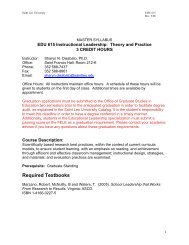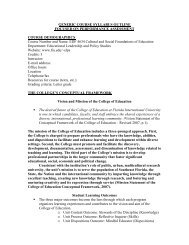2007 - College of Education - Florida International University
2007 - College of Education - Florida International University
2007 - College of Education - Florida International University
You also want an ePaper? Increase the reach of your titles
YUMPU automatically turns print PDFs into web optimized ePapers that Google loves.
neurologic innervation, hormonal status, skeletal structure, resting abdominal pressure, and<br />
collagen makeup. 3,7<br />
Three bones form the human pelvis: the left and right innominate, the sacrum, and the<br />
coccyx. Each innominate bone is formed by fusion <strong>of</strong> the ilium, ischium, and pubis. The bones<br />
are attached anteriorly by the symphysis pubis and posteriorly to the sacrum by the sacroiliac<br />
joints. The pelvis accommodates the bladder, urethra and ureters, vagina, and rectum.<br />
The bladder wall is composed <strong>of</strong> bundles <strong>of</strong> smooth (detrusor) muscle. Its unique<br />
compliance allows it to function as a low-pressure, high compliance organ that adapts to<br />
increasing volume with minimal increase in internal pressure. As the bladder fills during the<br />
storage phase, the walls stretch and it assumes a spherical shape. The detrusor muscle has a<br />
oblique arrangement <strong>of</strong> muscle fibers that is ideally suited to empty the spherically shaped<br />
bladder. Two U-shaped bands <strong>of</strong> fibers, known as the detrusor loops, lie at the bladder neck<br />
(urethrovesical junction) and can function as a spincter favoring closure. 14<br />
The trigonal muscle is a specialized smooth muscle surrounding the urethra at the bladder<br />
neck. It is composed <strong>of</strong> three parts: the trigone, the trigonal ring, and the trigonal plate. It is<br />
believed that the trigone contributes to the continence mechanism through alpha-andrenergic<br />
innervation, keeping this region <strong>of</strong> the bladder neck closed. 14<br />
The urethra is a hollow muscular tube, embedded in the anterior vagina wall. The wall is<br />
composed <strong>of</strong> a hormonally sensitive mucosa, a submucosal vascular plexus, and three muscular<br />
layers. The musculature is composed <strong>of</strong> longitudinal and circular layers <strong>of</strong> smooth muscle, and<br />
the striated urogenital sphincter muscle. The striated urogenital sphincter and the vascular<br />
submucosa are each responsible for contributing to approximately one third <strong>of</strong> the total urethral<br />
closing pressure at rest. 15<br />
The urogenital sphincter is divided into two parts that function as a unit: the sphincter<br />
urethra (which lies adjacent to the proximal one centimeter <strong>of</strong> the urethral lumen) and the<br />
urethrovaginal sphincter (which extends below this level). Both are primarily composed <strong>of</strong> slow<br />
twitch fibers, which maintain constant tone but have the ability to generate additional force when<br />
recruited, as would occur during coughing. 7 The striated muscle <strong>of</strong> this sphincter is contracted<br />
voluntarily both to interrupt urine stream and when a sense <strong>of</strong> urge is felt but the social situation<br />
is inappropriate for voiding. It is contracted reflexively during increases in intra-abdominal<br />
pressure when urethral resistance needs to be augmented. 14<br />
An estrogen-dependant submucosal vascular plexus encircles the urethral mucosa.<br />
Together, the mucosa and submucosa form a cushion that contributes to urethral closing<br />
pressure. The submucosa is a highly organized arteriovenous complex capable <strong>of</strong> filling and<br />
emptying. Therefore, it is thought to contribute to the continence mechanism mainly at rest, by<br />
filling the urethral wall and mucosa with blood and forming a hermetic seal. 15<br />
Interconnections <strong>of</strong> the three structures support the vesicle neck and proximal urethyra:<br />
the arcus tendineus fasciae pelvis, the endopelvic fascia (Figure 1), and the levator ani muscles.<br />
The arcus tendineus fasciae pelvis is a fibrous band <strong>of</strong> fascia that is attached ventrally to the<br />
pubic bone and dorsally to the ischial spine and provides a lateral attachment for the pelvic floor<br />
muscles and ligaments. The endopelvic fascia is the first layer <strong>of</strong> the pelvic floor. It consists <strong>of</strong><br />
the pubourethra ligaments, the urethropelvic ligaments, and the uterosacral ligaments and<br />
attaches the uterus and vagina to the pelvic wall. The pelvis is bordered caudally and dorsally by<br />
the PFM that provide support for the pelvic organs to relieve constant strain on the pelvic<br />
ligaments. 7
















